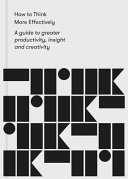

Mental models are frameworks that help individuals understand the world and make decisions. They simplify complex realities and provide a way to predict outcomes. The book emphasizes the need for diverse mental models, as relying on a single perspective can lead to flawed decisions. By cultivating a variety of mental models from different disciplines, readers can enhance their problem-solving skills and creativity. The author illustrates how successful thinkers, like entrepreneurs and scientists, leverage mental models to navigate challenges. The key takeaway is that developing a rich toolkit of mental models empowers individuals to think critically and effectively, leading to better decision-making and innovation.
Continue readingUncertainty is an inherent part of life and decision-making. The book highlights the importance of embracing uncertainty rather than fearing it. Effective thinkers recognize that not everything can be predicted or controlled, and they learn to operate within this ambiguity. The author provides strategies for managing uncertainty, such as scenario planning and probabilistic thinking. By accepting uncertainty, readers can make more informed decisions and adapt to changing circumstances. The takeaway is that by becoming comfortable with uncertainty, individuals can improve their resilience and flexibility, which are crucial traits in today’s fast-paced world.
Continue readingCollaboration is a critical component of effective thinking. The book discusses how diverse teams can generate more innovative solutions than individuals working alone. It emphasizes the importance of fostering an environment where different perspectives are valued and encouraged. The author shares examples of successful collaborations in various fields, illustrating how collective intelligence can lead to breakthroughs. The key message is that collaboration not only enhances creativity but also helps individuals challenge their assumptions and biases. By learning to work effectively with others, readers can expand their thinking and achieve greater outcomes.
Continue readingReflection is a vital process for effective thinking. The book argues that taking time to reflect on experiences and decisions is essential for personal growth and learning. The author provides techniques for incorporating reflection into daily life, such as journaling and mindfulness practices. By regularly reflecting on their thoughts and actions, individuals can gain insights into their decision-making processes and identify areas for improvement. The takeaway is that reflection enables continuous learning and helps individuals develop a deeper understanding of themselves and their thinking patterns.
Continue readingCuriosity drives effective thinking and innovation. The book encourages readers to cultivate a curious mindset, which involves asking questions, seeking new experiences, and challenging the status quo. The author explains that curiosity leads to exploration and discovery, which are essential for personal and professional growth. By embracing curiosity, individuals can expand their knowledge base and develop new skills. The key message is that a curious mindset not only enhances individual thinking but also fosters a culture of innovation within organizations.
Continue readingCritical thinking is a cornerstone of effective thinking. The book outlines the key components of critical thinking, including analysis, evaluation, and inference. The author provides practical exercises and techniques to help readers strengthen their critical thinking skills. By learning to analyze information objectively and evaluate arguments rigorously, individuals can make better decisions and avoid cognitive biases. The takeaway is that developing critical thinking skills is essential for navigating complex problems and making informed choices.
Continue readingThe environment in which individuals think can significantly influence their cognitive processes. The book discusses the effects of physical spaces, social interactions, and cultural contexts on thinking. The author emphasizes the importance of creating environments that foster creativity and effective thinking, such as collaborative workspaces and supportive social networks. By being mindful of their environments, readers can enhance their thinking capabilities and overall productivity. The key message is that a well-designed environment can facilitate better thinking and innovation.
Continue reading